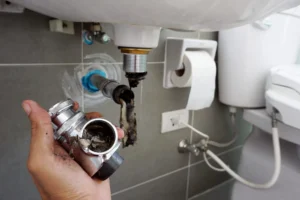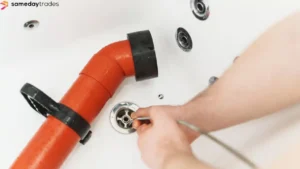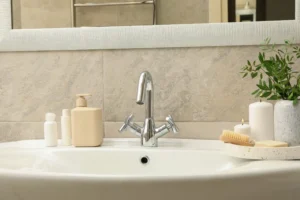It’s very frustrating when your bathroom sink gets clogged. It makes daily routine harder as you can not wash your hands or brush your teeth because dirty water stops passing. The very common causes of Blocked Bathroom sink are grimy debris, hair, soap etc. Over time, all these gunk sticks to the inside of drain pipes. As more debris accumulates, water gradually drains slower until eventually, a complete clog forms.
But often you can unclog the sink on your own without calling a plumber. Start by trying easy fixes using stuff you probably already have at home.
Use a Plunger
Plunging is an effective DIY method for loosening a mild to moderate bathroom sink clog. Fill the sink halfway with water and tightly seal off the overflow hole with a wet rag. Place the plunger directly over the drain hole to form a tight seal.
Quickly plunge up and down several times to dislodge the clog. Repeat for several minutes to create pressure inside the pipe. The suction force often pops loose debris that’s stuck, allowing water to drain freely again.
Try Using a Sink Plunger
Unlike a toilet plunger, a sink plunger features a narrower suction cup that fits fully over most bathroom sink drains. The small size optimizes the plunging pressure directly over the clog for maximum effectiveness. Like a toilet plunger, rapidly pump up and down with the sink plunger sealed over the drain hole to unclog the pipe below.
Attempt a Baking Soda and Vinegar Reaction
You can use the combination of baking soda and vinegar to clear sink clog. Mixing these two together creates a chemical reaction and form acid which you can use in clog cleaning.
Start by pouring about half a cup of baking soda down the sink drain followed immediately by equal parts hot water and vinegar. Place a sink stopper or wet rag over the drain hole opening to contain the foaming reaction in the pipe. Allow the mixture to sit for 5-10 minutes then rinse with more hot water. Over this short timeframe, the fizzy reaction helps eat away grease and gunk.
Use a Wire Coat Hanger
Unbend a wire coat hanger then straighten it as much as possible. Carefully insert the end into your sink drain then gently move it up and down while also twisting. The wire pokes holes in the clog while twisting action helps break up debris.
Be sure not to scratch your sink with the wire. Wrap a small section of cloth or paper towel around the end before inserting to prevent damage. Gently twist and move the hanger for a couple minutes to clear as much gunk as possible from inside the pipe. Finish by running hot water for a minute or two to flush away any remaining loose debris.
Try Using a Drain Snake
A drain snake (sometimes called an auger) has a long, flexible coil you manually feed down the pipes. Attach it to your electric drill then activate the drill while slowly lowering the spinning snake end into the drain opening. The spinning snake grabs and extracts built-up gunk.
Flush it Out With Boiling Water
As a last resort before calling a professional, pour a full kettle or pot of boiling hot water directly into the blocked sink drain. Avoid pouring large volumes quickly as this could crack the sink or pipes. Carefully pour steady streams while allowing a little time in between for cooling.
The intense heat melts and softens built-up grease clogs. Simultaneously, the water itself can help flush debris further down into the main wastewater pipes. For tough clogs near the drain hole opening, repeatedly pour 2-3 cups of boiling hot water at intervals of 2 minutes or so.
If trying all home solutions fails to unclog your bathroom sink, your best bet is to call a professional plumber. A plumber can use a special drain camera to see inside your pipes and identify the clog, then will use the proper tools to clear it. While a plumber costs more upfront, they can fully solve the problem and prevent future headaches.
Know When To Call A Professional Plumber
While handy homeowners can often successfully unclog a blocked bathroom sink themselves, don’t hesitate to contact professional help if needed. Persistent clogs that resist multiple attempts at clearing often require a plumber’s expertise and tools. Signs you should call for professional drain cleaning services include:
- Complete clog that causes a sink full of standing water with zero draining
- Slow drainage (more than 5 minutes to fully drain the sink)
- Unpleasant sewer gas odors coming from the drain
- History of frequent reoccurring clogs at the same sink
- Belly bulges or leaks underneath the sink indicating pipe damage
- Failed attempts using multiple methods to clear the clog yourself
Following these simple, DIY methods can often get your bathroom sink draining properly again without needing a plumber. But don’t hesitate to call a professional plumber if you try everything and still have an annoying clog in your sink that won’t go down.










